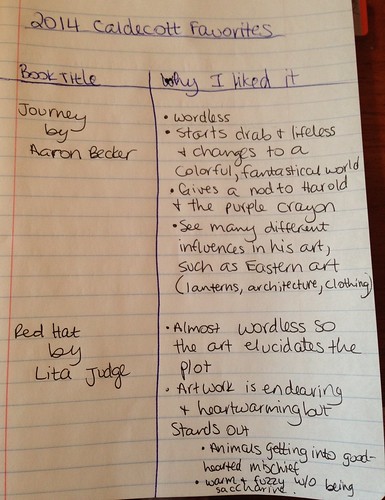But just what does distinguished mean?
Distinguished: (adjective) made noticeable by excellence; having an air of distinction or dignity
In making your decision you must keep this in mind: the Caldecott is awarded for illustration, not for text. You may only consider text only if it detracts from the illustration.
Here is the Caldecott critera from the ALSC website (I re-worded some of this to help you better understand the criteria):
-
In identifying a “distinguished American picture book for children,” defined as illustration, committee members need to consider :
-
Excellence of execution in the artistic technique used
-
Excellence of interpretation of story, theme, or concept through pictures
-
Appropriateness of style of illustration to the story, theme or concept;
-
Understanding of plot, theme, characters, setting, mood or information through the pictures;
-
Excellence of presentation in recognition of a child audience.
-
-
The only limitation to graphic form is that the form must be one which may be used in a picture book. The book cannot be dependent on other media (i.e., sound, film or computer program) for its enjoyment.
-
Each book is to be considered as a picture book. The committee is to make its decision primarily on the illustration, but other components of a book are to be considered especially when they make a book less effective as a children’s picture book. Such other components might include the written text, the overall design of the book, etc.
PROCEDURE FOR CHOOSING/WRITING ABOUT YOUR CALDECOTT PICK:
A. Read through the picture books provided to you in class, keeping notes about your favorites in your writer's notebook -- but ONLY considering illustration, not text.
 |
| Example of my notes. (These selections are from last year so as not to have my opinion influence yours) |
B. When you have made your choice, begin crafting an essay about the book you have selected, including the following:
- Mention the title, author, and illustrator of the book at the beginning of the essay
- A short summary of the story
- A description of the artwork (think about art terminology you have learned with Mrs. Ackley: use of color, lines, brush strokes, etc.)
- Reference the Caldecott criteria by explaining why you consider your selection to be "the most distinguished," how the illustrations help interpret the plot, why the artistic techniques used are superior to the other books, etc.
Here is an example of the writing I did for my favorite 2014 Caldecott pick, Journey by Aaron Becker:
Mrs. Shaum's pick for the 2014 Caldecott: Journey by Aaron Becker
(Note: This is my selection for last year's Caldecott so as not to have my opinion influence yours)
When a young girl is desperate for some attention from her family but they appear to be too wrapped up in their own lives to notice her, she draws herself into an imaginary land and can get herself out of any predicament with just a few lines drawn from a magical red crayon, invoking a nod to the classic children's book, Harold and the Purple Crayon by Crockett Johnson
Journey is an absolutely stunning, heart-skipping wordless picture book. It will make you gasp at its beauty and feats of imagination. What is so captivating about this picture book is the variety of influences you see in Becker's art, namely the Eastern influences, especially on the first full page spread where our protagonist enters the land of her imagination and you see paper lanterns strewn about the forest. That spread will make the reader's eyes bulge in wonder and heart skip a beat at the awe-inspiring transition from a colorless, depressing world to an adventurous, fantastical one. In going from one world to the next, the reader experiences a delightful, soul-stirring surprise.
To examine Becker's art further and noting why it should be considered distinguished, one merely has to look at the level of detail in his pen and ink/watercolor illustrations. In poring over the architectural marvels Becker created in this book, one would almost assume he had a background in architecture, and yet, his illustrations are so fantastical that his artistic abilities are likely too whimsical and outlandish to be of any practical use in the field of architecture.
In considering Becker's level of detail in the setting, one also has to consider another curiosity in his artwork and that is the lack of detail in the faces of the people he draws, namely the little girl who goes on this journey. This could be cause for criticism, however, I see it more as the artist's way of not imposing this journey on any one person -- it is, in essence, all of our journeys.
As a wordless picture book, Journey has all the things the Caldecott committee is looking for: excellence of artistic techniques, the use of illustrations to tell a story, timelessness, and appeal to a child audience.


No comments:
Post a Comment